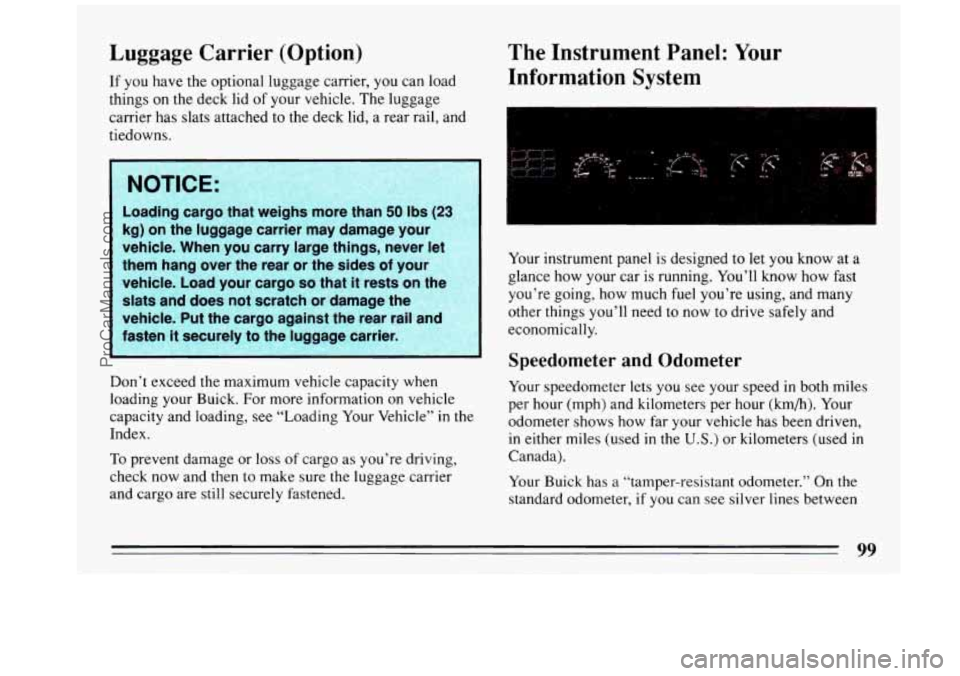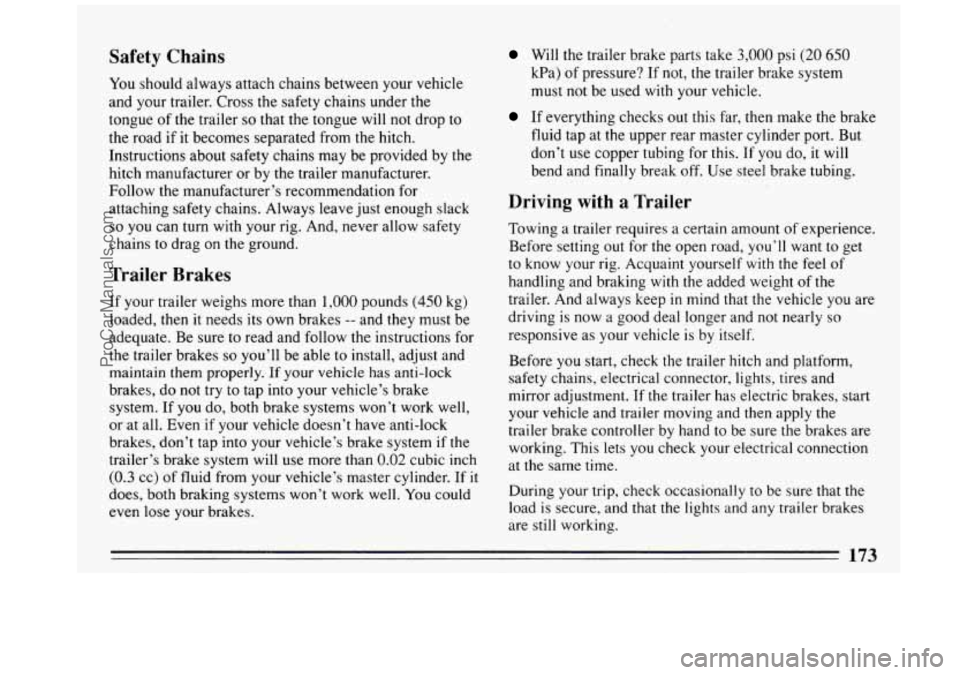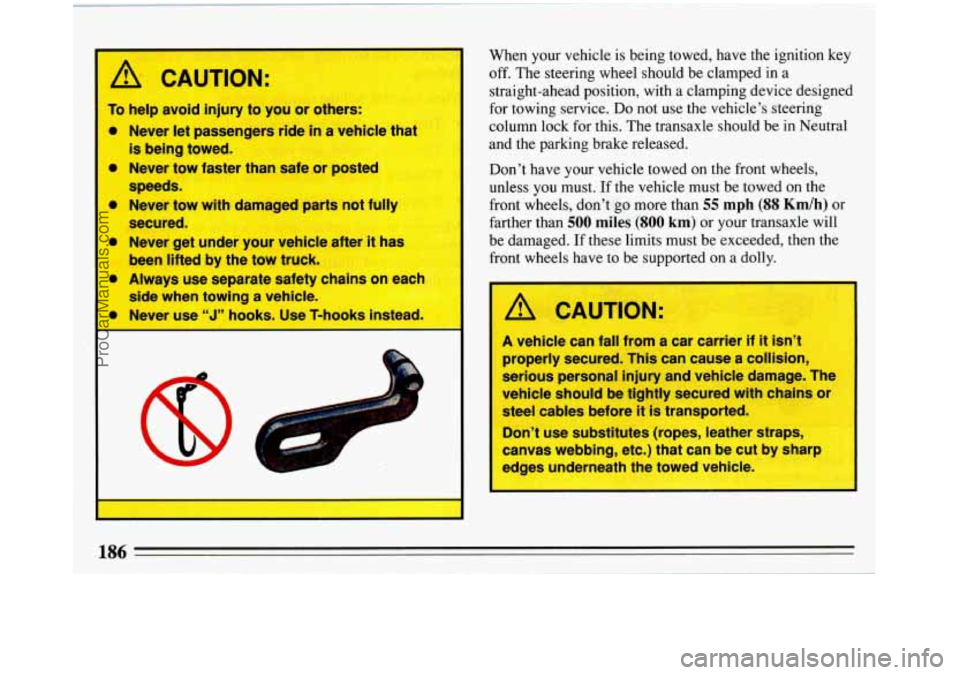Page 53 of 308
7. Run the belt through or around the child restraint.
The child restraint instructions will
show you how.
8. Put the hook on the free end through the slot in the
latch plate.
9. To make it tight, pull the belt while you push down
on the child restraint.
If the belt won’t stay tight,
switch it end for end.
-.i
10. Push and pull the child restraint in different
directions to be sure it
is secure.
51
ProCarManuals.com
Page 101 of 308

Luggage Carrier (Option)
If you have the optional luggage carrier, you can load
things
on the deck lid of your vehicle. The luggage
carrier has slats attached to the deck lid, a rear rail, and
tiedowns.
NOTICE:
Loading cargo that weighs more than 50 Ibs (23
kg) on the luggage carrier may damage your
vehicle. When you carry large things, never let
them hang over the rear or the sides
of your
vehicle. Load your cargo
so that it rests on the
slats and does not scratch
or damage the
vehicle. Put the cargo against the rear rail and
fasten
it securely to the luggage carrier.
\ia , -~~”,~,,””,,~,~~.~,~~--.~~~,,~, L ,,*., ’L <““<*,:r4s @:< ,%r.j>“, ..*,<, ,
The Instrument Panel: Your
Information System
Don’t exceed the maximum vehicle capacity when
loading your Buick. For more information on vehicle
capacity and loading, see “Loading Your Vehicle” in the
Index.
To prevent damage or loss of cargo as you’re driving,
check now and then to make sure the luggage carrier
and cargo are still securely fastened. Your
instrument panel is designed to let you know at
a
glance how your car is running. You’ll know how fast
you’re going, how much fuel you’re using, and many
other things you’ll need to now to drive safely and
economically.
Speedometer and Odometer
Your speedometer lets you see your speed in both miles
per hour (mph) and kilometers per hour (km/h). Your
odometer shows how far your vehicle has been driven,
in either miles (used
in the U.S.) or kilometers (used in
Canada).
Your Buick has
a “tamper-resistant odometer.” On the
standard odometer, if you can
see silver lines between
99
ProCarManuals.com
Page 168 of 308
Winter Driving
Here are some tips for winter driving:
Have your Buick in good shape for winter. Be sure
your engine coolant mix is correct.
0 Snow tires can help in loose snow, but they may give
you less traction on ice than regular tires. If you do
not expect to be driving in deep snow, but may have
to travel over ice, you may not want to switch to
snow tires at all.
You may want to put winter emergency supplies in
your trunk.
Include an ice scraper, a small brush or broom,
a supply
of windshield washer fluid,
a rag, some winter outer
clothing,
a small shovel, a flashlight, a red cloth, and a
couple of reflective warning triangles. And, if you will
be driving under severe conditions, include
a small bag
of sand, a piece of old carpet or a couple
of burlap bags
to help provide traction. Be sure you properly secure
these items
in your vehicle.
166
ProCarManuals.com
Page 175 of 308

Safety Chains
You should always attach chains between your vehicle
and your trailer. Cross the safety chains under the
tongue of the trailer
so that the tongue will not drop to
the road if it becomes separated from the hitch.
Instructions about safety chains may be provided by the
hitch manufacturer or by the trailer manufacturer.
Follow the manufacturer’s recommendation for
attaching safety chains. Always leave just enough slack
so you can turn with your rig. And, never allow safety
chains to drag on the ground.
Trailer Brakes
If your trailer weighs more than 1,000 pounds (450 kg)
loaded, then it needs
its own brakes -- and they must be
adequate. Be sure
to read and follow the instructions for
the trailer brakes
so you’ll be able to install, adjust and
maintain them properly. If your vehicle has anti-lock
brakes, do not try
to tap into your vehicle’s brake
system. If you do, both brake systems won’t work well,
or at all. Even if your vehicle doesn’t have anti-lock
brakes, don’t tap into your vehicle’s brake system if
the
trailer’s brake system will use more than 0.02 cubic inch
(0.3 cc) of fluid from your vehicle’s master cylinder. If it
does, both braking systems won’t work well.
You could
even
lose your brakes.
Will the trailer brake parts take 3,000 psi (20 650
kPa) of pressure? If not, the trailer brake system
must not be used with your vehicle.
If everything checks out this far, then make the brake
fluid tap at the upper rear master cylinder port. But
don’t
use copper tubing for this. If you do, it will
bend and finally break
off. Use steel brake tubing.
Driving with a Trailer
Towing a trailer requires a certain amount of experience.
Before setting out for
the open road, you’ll want to get
to know your rig. Acquaint yourself with the feel of
handling and braking with the added weight of the
trailer. And always keep
in mind that the vehicle you are
driving is
now a good deal longer and not nearly so
responsive as your vehicle is by itself.
Before you start, check the trailer hitch and platform,
safety chains, electrical connector, lights, tires and
mirror adjustment. If the trailer has electric brakes, start
your vehicle and trailer moving and then apply the
trailer brake controller by hand to be sure
the brakes are
working. This lets you check your electrical connection
at the same time.
During your trip, check occasionally
to be sure that the
load is secure, and that the lights and any trailer brakes
are still working.
172
ProCarManuals.com
Page 188 of 308

0
0
0
0 0
0
'AA"TT
To help avoid injury to you or others:
Never let passengers ride
in a vehicle that
is being towed.
Never tow faster than safe or posted
speeds.
Never tow with damaged parts not fully
secured.
Never get under your vehicle after
it has
been lifted by the tow truck.
Always use separate safetv chains on each
side when towing
a vehic ~
Never use "J" hnnks- Use T-hanks i
When your vehicle is being towed, have the ignition key
off. The steering wheel should be clamped in a
straight-ahead position, with a clamping device designed
for towing service.
Do not use the vehicle's steering
column lock for this. The transaxle should be in Neutral
and the parking brake released.
Don't have your vehicle towed on the front wheels,
unless
you must. If the vehicle must be towed on the
front wheels, don't
go more than 55 mph (88 Km/h) or
farther than
500 miles (800 km) or your transaxle will
be damaged.
If these limits must be exceeded, then the
front wheels have to be supported
on a dolly.
/1 CAUTION:
A vehicle can fall from a car carrier if it isn't
properly secured. This can cause a collision,
serious personal injury and vehicle damage. The
vehicle should be tightly secured with chains or
steel cables before
it is transported.
Don't use substitutes (ropes, leather straps,
canvas webbing, etc.) that can be cut by sharp
edges underneath the towed vehicle.
186
ProCarManuals.com
Page 239 of 308
Remove the plastic nuts that secure the trunk trim over
the taillights area.
1. Remove the plastic wingnuts of the taillamp bulbs
you want
to replace.
2. Pull the taillight away from body carefully, to avoid
scratching the paint or dropping
it.
3. Squeeze the bulb socket and turn it 1/4 turn to detach
it from the light.
237
ProCarManuals.com
Page 242 of 308
I A CAUTION:
l Tires
We don’t make tires. Your new vehicle comes with high
quality tires made by a leading tire manufacturer. These
tires are warranted by the tire manufacturers and their
warranties are delivered with every
new Buick. If your
spare tire is
a different brand than your road tires, you
will have a tire warranty folder from each of these
manufacturers.
above the tops of the seats
vehicle, secure
it whenever you can.
When you carry something inside 1
240
ProCarManuals.com
Page 249 of 308
Used Replacement Wheels
A CAUTION:
Putting a used wheel on your vehicle is
dangerous. You can’t know how it’s been used or
how many miles it’s been driven.
It could fail
suddenly
and cause an accident. If you have to
equipment wheel.
~ replace a wheel use anew GM original
I
Tire Chains
If your Buick has P215160RI 6
tires, don’t us
your vehicle.
If you have other tires, use tire chains only when
you must. Use only
SAE Class “S” type chains
that are the proper size for your tires. Install
them on the front tires and tighten them as
tightly as possible with the ends securely
fastened. Drive slowly and follow the chain
manufacturer’s instructions.
If you can hear the
chains contacting your vehicle, stop and
retighten them.
If the contact continues, slow
down until it stops. Driving too fast with chains
on
will damage your vehicle.
ProCarManuals.com